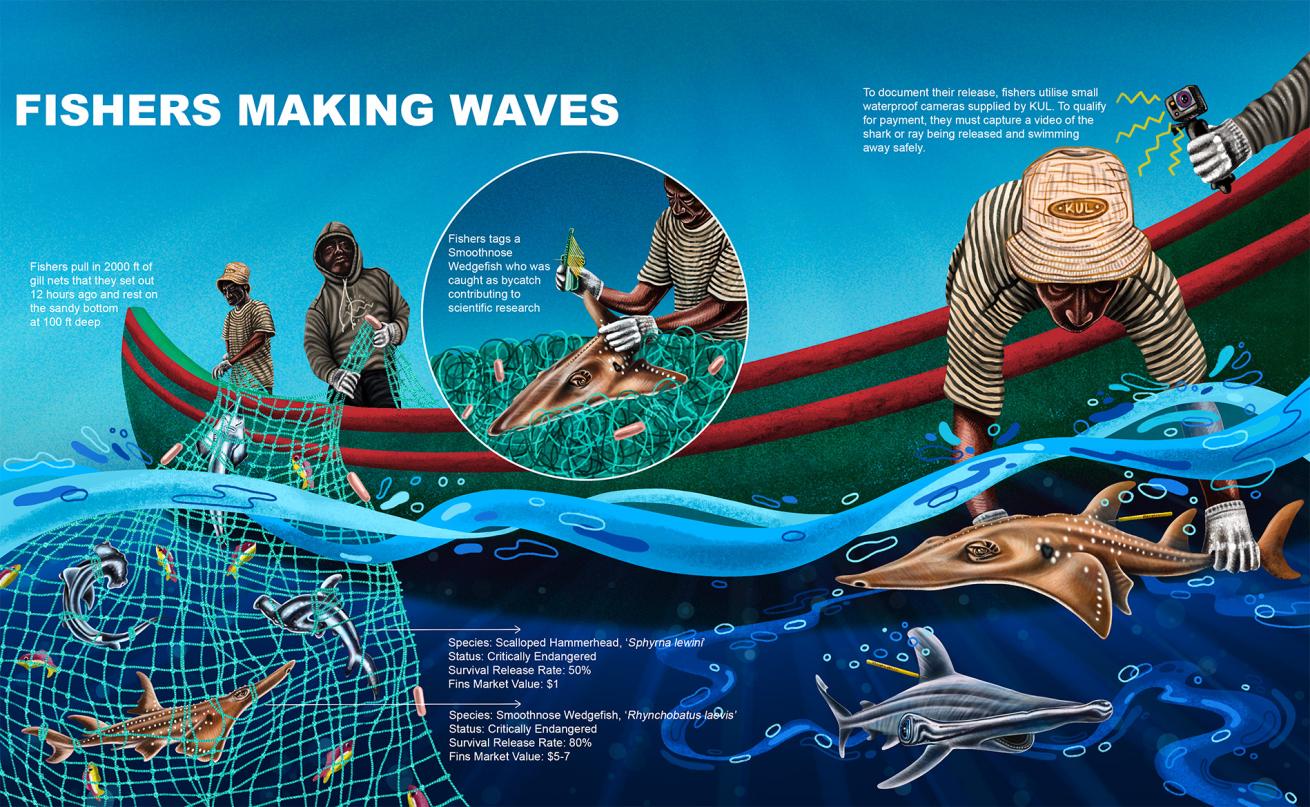Saving Indonesia's Endangered Sharks

To document their release, fishers utilize small waterproof cameras supplied by KUL. To qualify for payment, they must capture a video of the shark or ray being released and swimming away safely.
In Northern Sumatra, Indonesia, an initiative is quietly reshaping shark and ray conservation, offering a glimmer of hope amid the shadows of extinction. Indonesia is a key player in the shark fishing industry, and because of this, the country is facing an environmental crisis.
Species such as scalloped hammerheads and wedgefish are facing extinction because they are caught as bycatch and often sold for their fins. Kebersamaan Untuk Lautan (KUL), which translates to “Togetherness for the Ocean” in Indonesian, bridges conservation and community welfare by encouraging fishers to release the sharks and rays they catch incidentally. For each animal safely released, the fishers receive compensation from KUL.
Hollie Booth, a conservation scientist and founder of KUL, explains, “We need innovative approaches to solve these issues.” KUL’s incentive-based marine conservation project compares catches of fishers receiving payments with those not in a randomized control trial to evaluate impacts. The data they’ve collected indicates that this compensate-to-release program incentivizes conservation actions while supporting fisher well-being. Additionally, even fishers who are not participating or receiving payments report positive perceptions of the program.
Through continued monitoring and trials, the organization has been able to tweak the program to ensure that no one games the system. One tweak is capping the number of releases vessels can report in a given week based on average catches in the absence of the program. This disincentivizes catching more to release more. KUL also pays fishers less for the smaller wedgefish they catch and a more for the bigger ones, which more accurately reflects the market price.
Related Reading: 8 Best Places for Shark Encounters
In a remote village in Aceh Jaya Regency, Hasbi Fadillah, a local KUL fisher and Panglima Laot (Commander of the Sea—a customary leader in Aceh Province), says, “The sea is our ancestral legacy.” He sees KUL as crucial for the existence of sharks and rays and for the local community’s future. Azwar Anas, a regional leader, adds, “The ocean is for the people; it’s the source of our livelihoods. When the ocean is damaged, our source of living is damaged.” They reveal how much this project means to them, not just for safeguarding the ocean.
Fisher Sopyan says, “[KUL is a] very positive program which can prevent sharks and rays from becoming extinct so our children and grandchildren can enjoy them.” Sulastri, one fisher’s wife, explains how her family uses the compensation to fund their children’s education and household needs, adding, “Our income has been stable since joining the program.” With 30 percent of Aceh’s economy relying on fishing, balancing marine conservation and coastal livelihoods is crucial.
Related Reading: Rescued Endangered Sawfish in Florida Keys Dies in Captivity
KUL has equipped over 35 fishing boats (with two to three fishers per boat) with waterproof cameras to document the safe release of living sharks and rays for compensation. Hollie explains, “Since the sharks and rays have market value, they are kept to be eaten or sold. This forms a small but important part of fishers’ livelihoods.”
Correct compensation is crucial; too little fails to incentivize releases, while too much may encourage targeting. Research shows that the sweet spot for compensation is $5 to $7 per wedgefish and $1 per hammerhead. This is because the hammerheads fishers catch are primarily juveniles, so their fins are worthless, while wedgefish fins are perceived as high quality and are among the highest value in the shark fin trade.
“The ocean is for the people; it’s the source of our livelihoods. When the ocean is damaged, our source of living is damaged.”
KUL reports that over 1,000 critically endangered animals have been released since 2022. Fishers have also learned tagging and safe handling methods, contributing to scientific research. The research is ongoing; however, Hollie reveals that “wedgefish have at least 80 percent post-capture survival rates, while hammerheads are typically lower.” Despite not targeting them, bycatch remains significant, with gill nets catching up to 300 juvenile sharks daily in high season.
With two years of grant funding remaining, KUL is planning long-term financing options, hoping to establish a community-based conservation fund that divers and dive shops in other parts of Indonesia can contribute to, thus protecting the natural resources that the dive industry depends upon. Hollie states, “We want to set up mechanisms and institutions to scale success in the long run,” ensuring the protection of sharks and rays and local livelihoods for years to come.
With each release, KUL casts a ripple of hope, empowering fishers to fight for a better future for the ocean and the communities that rely on it.










